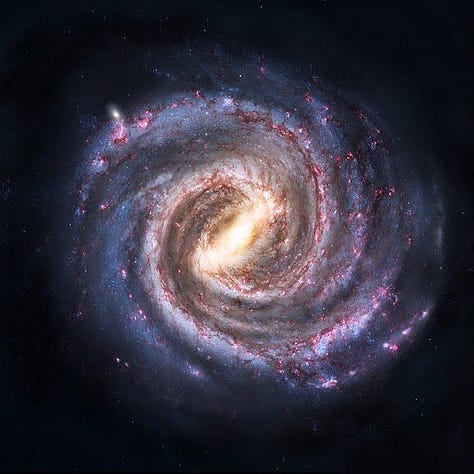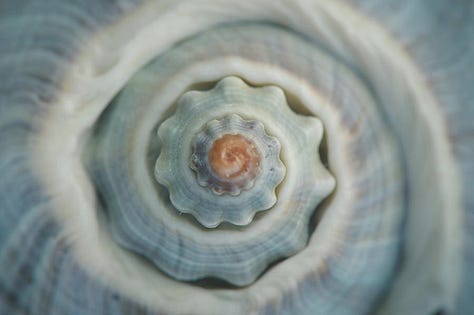Why is this Pattern Everywhere in Nature?
The Yin-Yang is more than you can possibly imagine, but easy to understand.
Everybody knows the yin-yang. You can travel to countries worldwide, and people will tell you they at least recognize the pattern—black turns into white, white turns into black, some back in white, some white in black. It nearly sounds like a Dr. Seuss rhyme, but it’s as real as you and me.
In my research, the yin-yang is older than recorded history. So, we won’t ever discover who created the pattern originally. My Taoism teacher, George, has a theory of how it was created, however. Take a look at the photos below and see if you recognize a familiar shape.



The pattern is clear throughout nature, from the tiny disk flowers in the middle of a sunflower to the medium-sized konk shell to the gigantic arms of a spiral galaxy. In fact, different cultures discovered the same pattern but through mathematics.
The golden ratio, often written as the Greek letter phi (φ), has been studied since at least 300 BCE in ancient Greece. This means different cultures from different parts of the ancient world noticed the same shapes and patterns in nature early in recorded human history. How can this pattern appear in so many living things, yet all life is completely random? What is it about the fabric and the foundation of life that continues to create this pattern?
The first chapter of the seminal book of Taoist philosophy, Tao Te Ching, states we don’t know the answer to that question and never will. Confused? Don’t worry. Let’s take a look.
The Tao that can be told is not the eternal Tao.
The name that can be named is not the eternal name.
The nameless is the beginning of heaven and earth.
The named is the mother of ten thousand things.
Ever desireless, one can see the mystery.
Ever desiring, one can see the manifestations.
These two spring from the same source but differ in name;
this appears as darkness.
Darkness within darkness.
The gate to all mystery.
If I told you I could explain the chapter above perfectly, I’d be lying, but I’ll give you my interpretation.
The first four lines state that the word we created, Tao, is not the real name of what we are trying to describe. It’s a word humans created because that’s how our brains function. Most humans communicate through sounds from our mouths to help with coordination. It’s advantageous to do so, after all. However, it’s important to remember that objects are not inherently the words we use to describe them.
A book is not a “book.” A book is paper, writing, ink, bindings, and more. If I travel to Mexico or France and hold up the object I call “book,” those Spanish and French speakers will say different words. Therefore, Tao is not really “Tao.” It’s much more than that. The names we give objects help us communicate but also limit what the object can mean to us—what the object can become.
In line three, the nameless means things without names—objects or experiences that are not confined by definition or description. Ten thousand things is an ancient Chinese expression for saying “everything.” It’s like when English speakers might say, “I had to walk one million miles to school each day.” We don’t mean literally one million miles; we mean a lot of miles. Line four, therefore, means our invention of naming and defining things caused everything else to receive names. Once you begin to describe something, you must describe what it is not. Therefore, what it is not now requires a new name. The process continues forever and will never stop.
Now that we know we can not truly name or define Tao, we move on to what we can do instead. If we are desireless, a.k.a. we do not wish to limit or confine the reality of existence to words, our minds are now open to experiences beyond words and our communication abilities. If we desire to define or control Tao, we will only be able to see its effects on us and the world around us, but we won’t be able to experience Tao because, as we have stated, Tao is beyond description.
Lines seven through ten explain that desire and desireless come from the same place. The duality of life comes from the same origin, as does everything else. This concept may seem strange or confusing, but modern science shows evidence of this—the Big Bang.
Scientists believe that the entire cosmos started as an infinitely small point and exploded into existence from nothing. Something from nothing. After more years than our mathematics can count, existence will return to nothing. A cycle, pattern, always returning. Darkness within darkness. The ability to experience this concept, not define it, is a pathway in your journey to explore nature and the universe around you. Chapter One of Tao Te Ching explains Tao is everything, yet nothing simultaneously.
Now, let us answer our question. Why does this pattern appear everywhere in nature?
Tao manifests in everything, and everything is a reflection of Tao.
Just as you are your reflection, you are also not your reflection. Your reflection is separate from you, but it is also exactly you. So, too, is Tao in all things. It flows inside them but does not control them. It moves and guides us yet doesn’t force us into any circumstance.
The yin-yang is Tao and Tao is yin-yang. When you look at a yin-yang necklace or bumper sticker, you are looking at all of reality. Everything within and without.
This naturally occurring pattern is the universe looking back at itself.
I invite you to take a few moments today to think about this, and I welcome your thoughts and comments. My favorite part about Taoism is that it welcomes interpretations and differences. What is your interpretation of chapter one? Feel free to chat with me or leave a comment!
I hope you enjoyed my latest article about the Yin-Yang. If you’d like to support me, I’ll be forever thankful. I’m running a special 40% off holiday discount right now, so hurry before you miss out!





